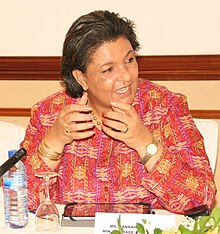Women in Ghana

|
|
| Gender Inequality Index | |
|---|---|
| Value | 0.565 (2012) |
| Rank | 121st |
| Maternal mortality (per 100,000) | 350 (2008) |
| Women in parliament | 8.3% (2012) |
| Females over 25 with secondary education | 45.7% (2010) |
| Women in labour force | 66.9% (2011) |
| Global Gender Gap Index | |
| Value | .06845 (2013) |
| Rank | 63rd out of 144 |
The social roles of women in Ghana have varied throughout history. The overall impact of women in Ghanaian society has been significant. The social and economic well-being of women as mothers, traders, farmers, and office workers has evolved throughout centuries and is continuing to change in modern day. Life for women in Ghana varies by generation, location, and culture.
Polygyny refers to marriages in which men are permitted to have more than one wife at the same time. In precolonial times, polygyny was encouraged, especially for wealthy men. Anthropologists have explained the practice was a traditional method for well-to-do men to procreate additional labour. In patrilineal societies, dowry received from marrying off daughters was also a traditional means for fathers to accumulate additional wealth. Today, the percentage of women in polygynous marriages in rural areas (23.9%) is almost double that of women in urban areas (12.4%). The age group with the most women in polygynous marriages is 45–49, interestingly followed by the 15–19 age group and the 40–44 group. Rates of polygynous marriages decrease as education level and wealth level increase.
In traditional societies, marriage under customary law was often arranged or agreed upon by the fathers and other senior kinsmen of the prospective bride and bridegroom.This type of marriage served to link the two families/groups together in social relationships; hence, marriage within the ethnic group and in the immediate locality was encouraged.The age at which marriage was arranged varied among ethnic groups, but men generally married women somewhat younger than they were. Some of the marriages were even arranged by the families long before the girl attained puberty. In these matters, family considerations outweighed personal ones – a situation that further reinforced the subservient position of the wife. The alienation of women from the acquisition of wealth, even in conjugal relationships, was strengthened by traditional living arrangements. Among matrilineal groups, such as the Akan, married women continued to reside at their maternal homes. Meals prepared by the wife would be carried to the husband at his maternal house. In polygynous situations, visitation schedules would be arranged. The separate living patterns reinforced the idea that each spouse is subject to the authority of a different household head, and because spouses are always members of different lineages, each is ultimately subject to the authority of the senior men of his or her lineage. The wife, as an outsider in the husband's family, would not inherit any of his property, other than that granted to her by her husband as gifts in token appreciation of years of devotion. The children from this matrilineal marriage would be expected to inherit from their mother's family. The Dagomba, on the other hand, inherit from fathers. In these patrilineal societies where the domestic group includes the man, his wife or wives, their children, and perhaps several dependent relatives, the wife was brought into closer proximity to the husband and his paternal family. Her male children also assured her of more direct access to wealth accumulated in the marriage with her husband.
...
Wikipedia
